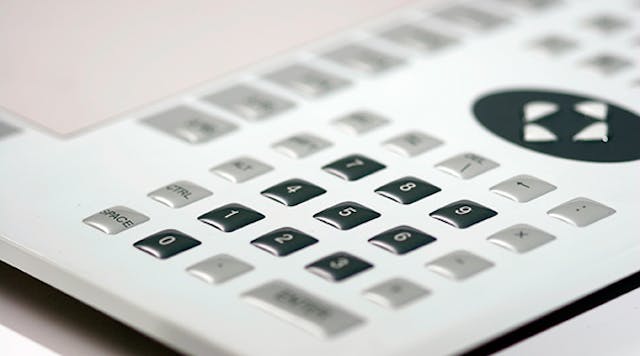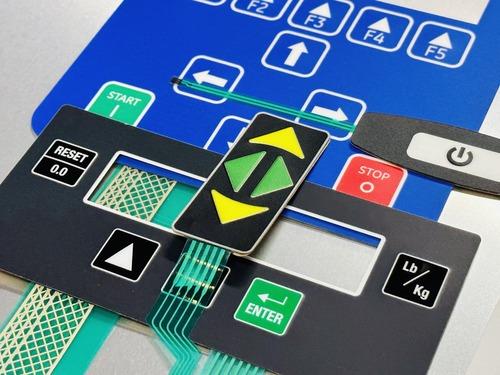Membrane Switches: The Best Choice for Compact and Reliable Controls
Membrane Switches: The Best Choice for Compact and Reliable Controls
Blog Article
Understanding the Significance of Membrane Switches in User Interfaces
Membrane buttons are essential components in the layout of reliable interface, helping with not only functionality yet also improving aesthetic charm and customer interaction. Their distinct attributes, such as resistance to personalized styles and ecological elements, make them ideal for a varied selection of applications throughout multiple sectors. As we discover the different benefits and future fads associated with Membrane innovation, it becomes clear that these buttons are greater than simply elements; they stand for a convergence of technology and practicality. The effects of this technology on customer experience deserve examining further.
What Are Membrane Buttons?

The spacer layer, which has glue homes, enables for the splitting up of the circuit layer from the overlay, ensuring that the button continues to be in a non-activated state till pressed. When pressure is used to the overlay, it compresses the spacer layer, connecting the void and completing the circuit in the underlying layer. This style not only decreases the physical space needed for conventional mechanical buttons but also improves the durability of the device, as Membrane switches are normally resistant to dust, moisture, and various other environmental elements.
Generally found in applications ranging from consumer electronics to clinical tools, Membrane buttons are indispensable to modern technology, providing a efficient and easy to use interface that straightens with modern design demands.
Benefits of Membrane Switches
While numerous button innovations exist, Membrane Switches offer unique advantages that make them specifically desirable in numerous applications. Among the key benefits of Membrane switches is their portable style, which permits space-saving executions in tools where genuine estate is limited. Their slim profile not just boosts visual allure but also helps with light-weight construction.
Another substantial benefit is their resistance to ecological factors. Membrane switches are generally secured against moisture, dirt, and contaminants, making them excellent for usage sought after atmospheres, such as clinical devices and commercial equipment. This longevity prolongs the life-span of the button, lowering upkeep costs and boosting integrity.
In addition, Membrane switches can be personalized to meet specific layout demands, integrating special graphics and colors that boost user interaction. Their responsive comments alternatives can additionally be customized to offer a satisfying customer experience. In addition, Membrane switches are economical, specifically in high-volume applications, as they can be created efficiently.
Applications in Numerous Industries

In the consumer electronics industry, go to website Membrane switches prevail in tools such as microwaves, cleaning equipments, and remote controls. Their responsive comments and visual alternatives boost individual experience while giving a streamlined, modern-day look. In addition, automotive producers make use of Membrane buttons in dashboard controls and infotainment systems, where area is limited, and customer engagement is vital.
Furthermore, the industrial sector leverages Membrane switches in control panels for equipment and tools, enabling user-friendly operation in typically extreme settings. Their resistance to chemicals and wetness ensures longevity and dependability in these applications. In general, the flexibility of Membrane Switches adds dramatically to their prevalent usage, making them important in numerous technological domain names.
Style Considerations for Membrane Buttons

When developing Membrane buttons, several essential factors to consider should be considered to make sure optimal capability and customer experience. The option of materials is crucial; selecting resilient, top notch substratums can enhance the button's durability and resistance to ecological variables such as moisture and temperature level variations.
Second of all, the style of the visuals overlay should focus on quality and convenience of usage. Symbols and message should be clear, and the design should help with instinctive communication (membrane switches). In addition, responsive responses is vital; integrating a tactile dome or various other devices can boost the customer experience by offering physical verification of activation
An additional vital variable is the button's electric performance. Designers need to make sure that the conductive traces are appropriately created to decrease resistance and stay clear of signal interference. This involves evaluating the called for actuation force and ensuring compatibility with the digital components they will interface with.

Future Trends in Membrane Technology
As technology remains to advance, Membrane switches are poised to evolve substantially, driven by innovations in materials and manufacturing methods. One emerging pattern is the consolidation of advanced materials, such as conductive inks and adaptable substratums, which enhance longevity and lower the total weight of Membrane switches. These materials not just enhance the responsive feedback yet likewise permit the layout of switches that can withstand harsher ecological conditions.
Furthermore, the integration of touch-sensitive best site technologies is transforming typical Membrane Switches right into even more interactive interface. Capacitive touch sensors installed within Membrane button browse this site panels can provide an extra receptive and instinctive user experience, lining up with the expanding need for smooth, contemporary designs in consumer electronics.
Additionally, innovations in printing techniques, such as digital and 3D printing, make it possible for rapid prototyping and customization of Membrane buttons. This flexibility enables producers to react quicker to market needs and customer preferences.
Lastly, sustainability is becoming a significant focus, with manufacturers discovering green materials and procedures. As these fads unravel, the future of Membrane modern technology guarantees enhanced capability, aesthetic appeal, and environmental obligation, strengthening their duty in innovative interface throughout numerous industries.
Final Thought
To conclude, Membrane Switches represent a vital element in the design of customer interfaces, incorporating performance with visual versatility. Their advantages, including sturdiness and resistance to environmental factors, make them ideal for diverse applications across different sectors. Additionally, thoughtful style factors to consider improve individual interaction and experience. As innovations in modern technology continue, the development of Membrane switches is expected to further improve interface, driving development and improving use in a progressively complicated technological landscape.
Membrane buttons are important elements in the design of efficient user interfaces, helping with not only performance however additionally enhancing visual charm and individual interaction.Membrane Switches serve as a crucial component in various user interfaces, facilitating a smooth communication in between customers and digital gadgets.While numerous button technologies exist, Membrane Switches deal unique advantages that make them especially preferable in numerous applications.In addition, Membrane switches can be tailored to fulfill particular design needs, including unique graphics and colors that improve customer communication.In conclusion, Membrane Switches represent a vital part in the design of user interfaces, combining functionality with visual adaptability.
Report this page